#Kyōgen
Explore tagged Tumblr posts
Text
Ado's Release Schedule Issue
Zanmu came out today and I was very excited to listen to it! It's definitely a light album than Kyōgen, which I think was necessary so she doesn't get trapped in the box/label of "that one angry/sad Japanese singer" (which I've unfortunately see happen to a lot of artists).
However, the release of single before the album was...not what I was hoping for. Out of the 16 songs on the new album, 14 of them were singles, the first of which being released in March of 2022 and the most recent of which being released 5 days before the album came out.
To her credit, a big reason behind this could be that half (yes, HALF, I counted) of the songs on her new album were created for projects besides Zanmu (Missing, Dignity, Chocolat Cadabara, Kura Kura, Rebellion, All Night Radio, Himawari, and Show). This means that she had to put these songs out early to meet deadlines for projects. It also wouldn't benefit her to use part of the songs for the projects and then not make money off of them during the heights of their popularity.
I don't know what role her music label played in Ado's release schedule/structure, but here's what I would've done if I was in charge of it. Release a two-part single with Missing and Rebellion on October 14th, 2022 to line up with the release of Karada Sagashi. Then, release Dignity, Kura Kura, and Himawari as singles on the release dates of their respective shows/films/etc. This will occur between July 11th, 2023 and October 7th, 2023. A week later, release All Night Radio alongside the previous singles, or even add in the songs from Karada Sagashi if it needs to be padded out, as an EP.
Now here comes the part where things get a little fuzzy, so just bear with me. Show aired its first commercial for Universal Studios Japan on September 6th, 2023. Chocolat Cadabara aired it's first commercial for Lotte on January 22, 2024. So, my proposal is that Zanmu be given a release date of late January 2024 and have Ado's Utattemita Album pushed back to late July 2024. Show and Chocolat Cadabara would be singles for Zanmu, but that leaves quite a bit of time between the two releases. This leaves the perfect opportunity for Mirror, which was used in most Zanmu promotional materials, to release in November of 2023. This also might've helped promote Ado's world tour, Wish, even better because it began in February 2024, meaning that everyone would be excited from the new, original, album (Show would also still be able to be used for promotional materials).
With Ado's Utattemita Album, all of the songs on there were already available to see Ado sing on YouTube, so it would still make sense if Ado sang them on her world tour. Even if she hadn't, it could be a surprise or sneak peak of sorts for people who attended Wish. (Also, I personally wasn't as excited about Ado's Utattemita Album releasing, so I wouldn't have minded waiting longer for it).
I don't blame Ado, or even the people who produced the music, for any of this. I think this was mostly an oversight on the part of her label and manager with how schedules for her different projects would work out. If you are new to Ado, I still encourage you to listen to Zanmu, but I would suggest listening to Kyōgen first
#guys#i love ado#i swear#ado#adomination#zanmu#zanmu ado#utaite#ado singer#japanese music#music#Kyōgen#Kyōgen Ado#Ado's Utattemita Album#wish ado#ado world domination#ado world tour#jpop
3 notes
·
View notes
Text

狐の孫[Kitsunenomago] Justicia procumbens
狐[Kitsune] : Fox
の[No] : Of
孫[Mago] : Grandchild
癸亥 永德 三 後小松天皇○和語連珠云、泉州堺南莊少林寺の塔頭耕雲菴に、永德年中の住僧に、伯藏主と云へり。此僧鎭守の稻荷大明神を信仰して、每日法施怠らず、或時神應ありて森の中に、三足の野狐をみる。抱き歸りて、養受(愛)す。此の狐に靈ありて、隨時の用を達󠄁��、賊󠄁難を追󠄁ふことあり。其狐の孫亦三足にして、今に至て、寺内に住居す。稻荷の靈驗あらたなり。世に傳云、釣狐の狂言(又吼噦とも云)は、此寺より發れり。尙狐の骨髓動轉を口傳せしとかや。
[Mizunoto|Kigai, eitoku san Gokomatsu tennō ○ Wago-renju ni iu, senshū sakai nansō shōrinji no tatchū kōun'an ni, eitoku nenchū no jūsō ni, hakuzōsu to ieri. Kono sō chinju no inari daimyōjin wo shinkō shite, mainichi hōse okotarazu, aru toki shin'ō arite mori no naka ni, mitsu-ashi no yako wo miru. Idaki kaerite, yōai su. Kono kitsune ni rei arite, zuiji no yō wo tasshi, zokunan wo ou koto ari. Sono kitsune no mago mata mitsu-ashi nishite, ima ni itarite, jinai ni jūkyo su. Inari no reigen arata nari. Yo ni iitsutau, tsurigitsune no kyōgen(mata konkai tomo iu)wa, kono tera yori okoreri. Nao kitsune no kotsuzui hataraki wo kuden seshi tokaya.]
Water Boar (60th term of the sexagenary cycle), 1383 A.D.
The reign of Emperor Gokomatsu. The following is written in the book Wago-renju. There was a monk named Hakuzōsu who lived in Kōun'an, a side temple of Shōrin-ji temple, in the south area of Sakai, Izumi Province(now a part of Osaka Prefecture), in the Eitoku period(1381 - 1384). This monk was a devotee of the tutelary deity, Inari Daimyōjin, and did not neglect to recite sutras and chant legal texts daily. One day, feeling a sign from the deity, he went into the forest and saw a three-legged (white) wild fox (that had lost one of its legs). He took it in his arms and went home, and raised it lovingly. The fox had a spiritual nature, could notify fortunes and ward off banditry. The grandchild(descendants) of the fox, also three-legged, still lives in the temple. The Inari Myōjin possesses miraculous powers. It is said that Kyōgen Tsurigitsune (it is also called Konkai) originated from this temple. And, they say the fox orally passed on the essence of the actions (of that kyōgen). From 近畿能楽記[Kinki nōgaku-ki](The noh record of the Kinki region) by 野々村 戒三[Nonomura Kaizō] Source: https://dl.ndl.go.jp/pid/1209487/1/136 https://en.wikipedia.org/wiki/Inari_Ōkami https://www.loc.gov/item/2021668983/ https://collections.mfa.org/objects/540238
21 notes
·
View notes
Text
Deep Cover/ディープカバー
Under
It’s all the same, that worthless dependence
Under
That need for warmth that lowers your defenses
Useless now, and useless then
You're so damn full of it, you're full of it, the worst and
Under
It still won't change, the queen will play her own game
Under
We stay the same, yet stealing for our own gain
Useless now, and useless then
And yet you love them and you're trying to make amends
So weigh the scales in your brain
Show me who’s wrong and take aim
That's why I swore that I would always have your back
Be the fanged hero on the attack
Fixed the problems that you couldn't fix
So why then, oh, why then did it come to this?
Don't stop me! Leave me be!
I need a reason to dish justice, can’t you see?
Inform me and warm me
Give me the solemn purpose I need
Under
Hiding from light, greedy, in spite of your conscience
But in the night, praying the righteous can imprint
Useless now, and useless then
Do you remember what you’re doing this for, instead
Under
He can't be found, chained and bound in his memories
Under
You wanna play? I’ll show you justice with ease
Useless now, and useless then
Let's knock the door down and begin!
So be my reason, be my motivating task
Don't you see? Pity’s just there to distract
Can't you hate evil for what it is?
Can’t you make the choice to not forgive?
Don't stop me! Leave me be!
I need a reason to dish justice, can’t you see?
Inform me and warm me
Give me the solemn purpose I need
Under
Under
I wanna find the justice I’ve been seeking
I wanna crush the evil I’ve been reaping
Useless now, and useless then
Count on me and I’ll defend
That's why I swore that I would always have your back
Be the fanged hero on the attack
Fixed the problems that you couldn't fix
So why then, oh, why then did it come to this?
Don't stop me! Leave me be!
I need a reason to dish justice, can’t you see?
Inform me and warm me
Give me the solemn purpose I need
Let me be! I’m not weak!
Give me the solemn purpose I need
Under
You think you’ve 1, you worthless parasite?
Under
That vulgar slut needs someone 2 hold tight
Under
It’s easy 4 me to see through her lies
Under
5fold suffering, dissecting what is alive
Under
7’s a liar, acting in a kyōgen*
Under
See that warden, that useless eleven
Useless now, and useless then
You all depress me now, you’re all so damn annoying
*Kyōgen (狂言) is a traditional comic Japanese theatrical form that is usually performed in between Nō plays. In Cat, the word kyōgen (狂言) is used to refer to the theatrical form, whereas in Deep Cover, the word used is kyogen (虚言), meaning liar.
#translyrics#vocaloid#lime's translyrics#vocaloid song#hatsune miku#deco*27#milgram#yuzuriha kotoko#kotoko yuzuriha
54 notes
·
View notes
Photo
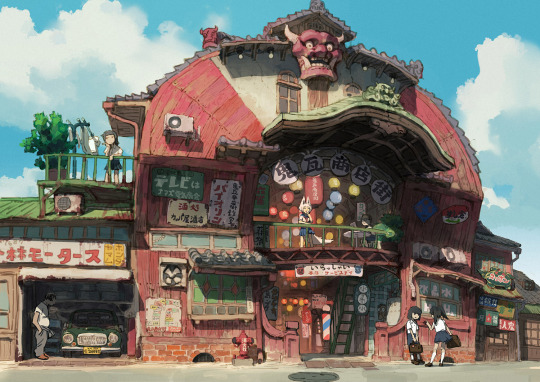
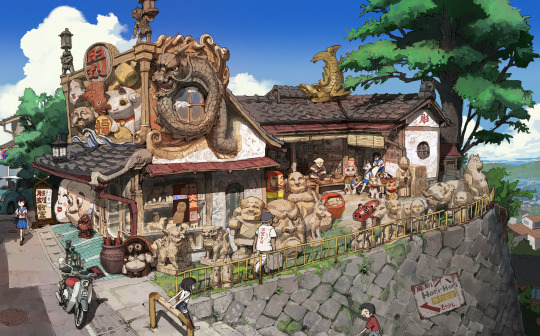
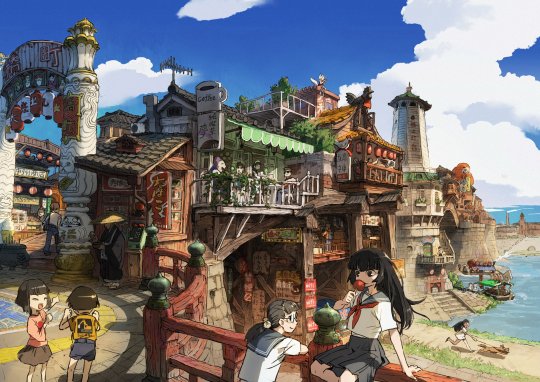
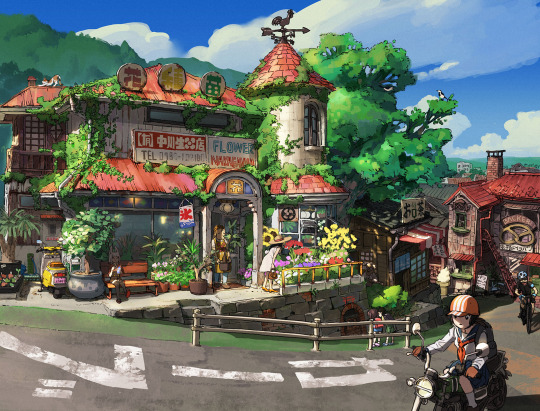
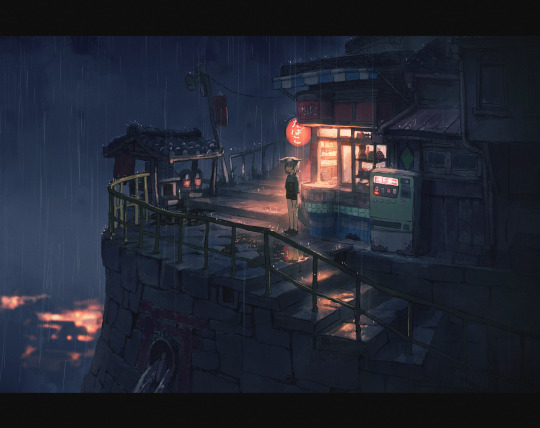
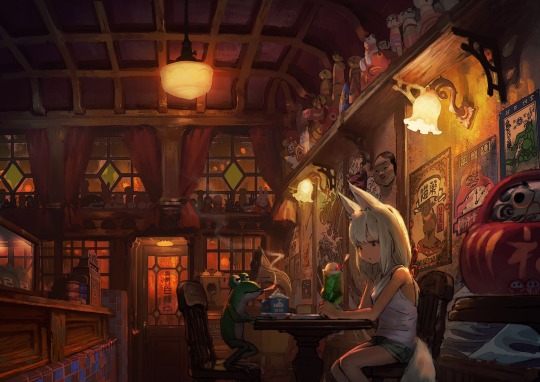
Artwork for the upcoming adventure game Kitsune: The Journey of Adashino, by RIAS.
Since its reveal last year, the it has been showcased in select independent game events with a brief playable demo that has nevertheless managed to attract the attention of the western press. It has also been listed on Steam and is expected to launch in 2024.
Its use of 3D character models over hand-drawn backgrounds evokes the style and atmosphere of late 1990s RPG adventure games, a genre which Japanese developers have allowed to perish to a large extent. The author and lead designer, RIAS, has noted that when contemplating the creation of a game, he opted to embrace the traditional Japanese folklore motifs with which he has been in contact with his entire life. These images attest to this keenness, as seen in the countless references to Shinto deities and iconography, in which kitsune, the fox, is often portrayed assuming the shape of a young woman; together with the presence of many other elements so closely associated with the traditions of Kyōgen and Noh theater.
89 notes
·
View notes
Text
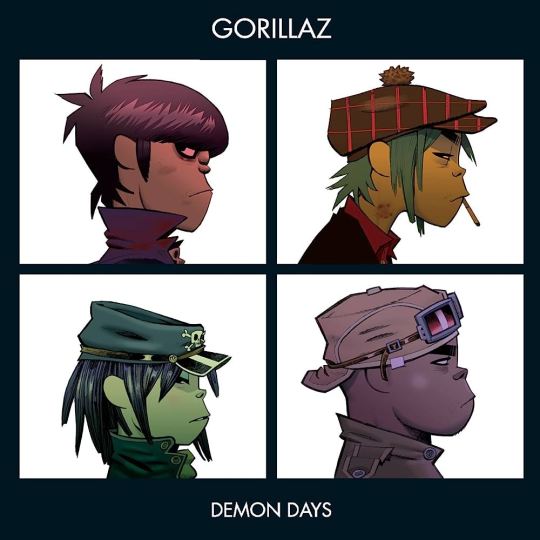

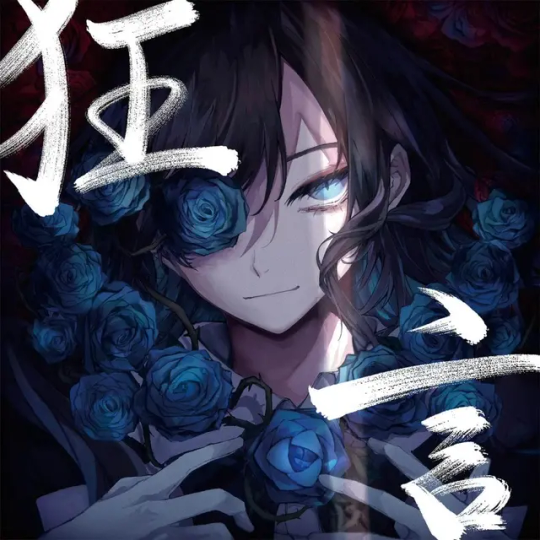





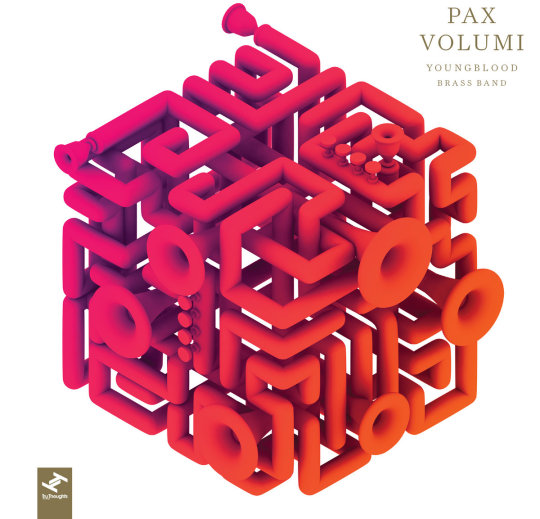
Some of these can change depending on my mood, but I felt like sharing a 3x3 of my favorite albums:
Demon Dayz - Gorillaz
American Idiot - Green Day
Kyōgen - Ado
El Camino - The Black Keys
Random Access Memories - Daft Punk
No One Ever Really Dies - N.E.R.D.
Collision Course - Jay-Z & Linkin Park
Czarface Meets Metal Face - Czarface & MF DOOM
Pax Volumi - Youngblood Brass Band
30 notes
·
View notes
Text
AME-NO-UZUME // SHINTO GODDESS OF DAWN, MIRTH, MEDITATION, REVELRY & THE ARTS
“She is the goddess of dawn, mirth, meditation, revelry and the arts in the Shinto religion of Japan, and the wife of fellow-god Sarutahiko Ōkami. She famously helped draw out the missing sun deity, Amaterasu Omikami, when she had hidden herself in a cave. She is depicted in kyōgen farce as Okame, a woman who revels in her sensuality.”


(left illustration shows Uzume dancing to lure out Amaterasu)
0 notes
Note
huh… kinda funny that kyogen, at least, doesn’t have an ironic meaning- kyōgen (狂言) is actually a form of comic theatre from japan, usually performed as a sort of intermission between the usually more serious noh (能) acts. it’s just a bit ironic, given kyogen’s life is… not exactly comedic, itself, haha. that aside! another question- how good are each of your ocs at cooking and baking? do they want to get better, and if they do, who would they ask to teach them?
Oh yea! That did remind me I did look up her name a while ago:

The emphasis on the 'mad words' was a pretty big focal point too, but I really like the association you gave with her life lol.
As for the question, they’re all equally bad at baking, none of them grew up in environments that allowed them time to experiment, though Elise would like to learn baking in general! Kyogen would probably like to learn how to make the more traditional treats (mochi, etc). The others aren’t too interested.
Cooking, I’ll rank them in order:
1. Kyogen (learned by herself, though Sharpnote sometimes “helped”. Does get better as she grows up and her home situation improves. Most like would seek help from Holly)
2. Silver (taught by Chad, an officer who took her and the other two in. Cooks the meals when Worick doesn’t. She tries her best with what they have and waits for the day when they can have good meals. She’d probably ask Aizawa, but he’s not the pinnacle of examples…)
3. Elise (only recently learned thanks to her brother, who’s also kind of a bad cook. Katsuki does teach her more and to improve later on, and if not him, she asks her uncle or the other students who can cook well.)
4. Mayuri (has never cooked in her life and do not let her. But she does want to improve to gain her own agency. She’s obviously ask her caregivers, either Aizawa or Nighteye.)
#jjba oc#mha ocs#bnha oc#my oc stuff#📁.mayuri chibana#📁.kyogen wind#📁.elise wing#📁.silver/nanashi#💌.letters#?.main oc things
0 notes
Text
japanese folklore
As objects of art, religion or rituals, masks are omnipresent in most of the world's cultures. The oldest Japanese vestiges date back to prehistory. Back then, they were produced out of clay, except for the famous Ataka mask, which was carved out of shells. Provided with holes, it is quite possible that Japanese masks were already designed to be placed on the face. Later on, according to an old Japanese tradition, masks were worn by dancers for religious cults, including the Gigaku mask. Kamen masks were imported from Korea and used to celebrate the art of dancing, singing and music before being used by Noh theater and kyōgen, around the 14th century. As a major element of the show, the mask comes to life when on stage. The actor merges with the character by wearing the mask on his face. As a result, Noh theater counts over 250 different entities (spirits, demons, men, women, old people). These masks are known to have different expressions depending on their inclination. As for the masks of kyōgen, these ones have a comical aspect and are absurdly exaggerated.


This Japanese demon mask with its crimson face and frightening look is very common in Japanese folklore. And with its long red nose... we can say he is easily recognizable! According to the legend, this figure is a remnant of his bird past, once he became human. In addition, the Tengu demon is often represented with a pair of wings on its back. In Japanese culture, wearing a Tengu mask serves not only as artistic expresions but also as a protective charm, believed to repel evil spirits and attract good fortune. Tengu masks hold significant importance in a range of Shinto and Buddhist ceremonies. Both demon and deity, he symbolizes the mysterious forces of nature and the complexity of spiritual experience. Its evolution from enemy of Buddhism to protector of the mountains reflects changes in religious and philosophical perception in Japan. Considered to be both a yokai and a kami (Japanese deity), this Japanese war-heralding demon embodies the spirit of the mountain, much feared by the Japanese. Tengu masks are very popular in Noh theater as well as for Shinto celebrations. Besides, in Japan, if you are told to be "a Tengu" means that you are particularly pretentious...


Kitsune have become closely associated with Inari, a Shinto kami or spirit, and serve as its messengers. This role has reinforced the fox's supernatural significance. The more tails a kitsune has, up to nine, the older, wiser, and more powerful it is. One major reason for the kitsune's massive popularity is its association with Shinto religious beliefs. Nearly half of the country practices that religion. In the eyes of a Shinto believer, kitsune are messengers and servants of Inari, the Shinto deity of rice, fertility, and prosperity .This fox mask originating from Japanese legends is worn on many festival-goers' faces during Shinto ceremonies. Messenger of Inari, the goddess of rice, business and prosperity, the Kitsune is a yokai that is worshipped as a kami (deity). For this reason Japanese people wear a mask with its effigy during these ceremonies... In order to attract good favors and thus ensure a good harvest! This clever and malicious Japanese fox has many powers, including the ability to transform into a beautiful young woman: In human form, it plays at seducing men.


Hannya's mask represents an angry face with two pointed horns, big sad and hateful eyes, a demonic smile with pointed canines and tousled black hair. She makes frequent appearances in Noh plays. The hannya mask is used in many Noh and kyōgen plays, as well as in Shinto ritual kagura dances. The hannya mask portrays the souls of women who have become demons due to obsession or jealousy, similar to the Buddhist concept of a hungry ghost. Declined in many colors with different meanings: red represents the crime of passion and jealousy; green represents anger and rage etc.


Ko-omote represents the idealized face of an aristocratic young woman from the Heian period (794-1185), which was considered as the standard of elegance in medieval Japan. Ko-omote masks feature a fair complexion, with three thick hairlines neatly combed along the sides and fuzzy eyebrows painted high on the forehead. Most familiar of the onna-men (female masks), ko-omote represents a pure and innocent young girl in her teens. Still blissfully ignorant about life, her naivete can occasionally make her seem a little unforgiving. 'Ko' in Ko-omote means pretty or lovely, with graceful curves that characterise this mask.


The daruma is a lucky charm that watches over you to make sure that the wishes you ask for come true, and it is also used as a decorative talisman to ward off misfortune in the home and the workplace. The daruma is usually painted red because in Japan red has long been believed to ward off evil spirits and poor health. The eyes of Daruma doll are blank when sold as a means to keep track of goals or big tasks and motivate them to work to the finish. The recipient of the doll fills in one eye upon setting the goal, then the other upon fulfilling it. In this way, every time they see the one-eyed Daruma, they recall the goal. The true meaning of the daruma doll lies in its role as a reminder of self-sufficiency, focus, and discipline. It encourages perseverance and dedication, emphasizing the importance of personal effort in achieving one's goals. Bodhidharma, the founder of Chan/Zen Buddhism, championed the importance of self-discipline


The maneki-neko (招き猫, lit. 'beckoning cat') is a common Japanese figurine which is often believed to bring good luck to the owner. In modern times, they are usually made of ceramic or plastic. The figurine depicts a cat, traditionally a calico Japanese Bobtail, with a paw raised in a beckoning gesture. The Maneki Neko is a traditional Japanese figurine that has become a beloved and famous symbol of good fortune and prosperity. This lucky talisman is common in businesses and homes throughout Japan and other parts of Asia.
#gowns#fashion photography#ready to wear#fashion#fashion design#fashion illustration#fashion marketing#japanese art#japanesepatterns#japan history#japan travel#japan trip#japan fashion#japan#japanese#jojo no kimyou na bouken#jojo's bizarre adventure#anime art#anime and manga#anime
0 notes
Text
After Joey left I feel slighly melancholic. But yesterday I got very good news that I can return to Norway and still do my masters online!

Here is my new kimono, for autumn. I actually want one more... one which has a very bright color, but the problem is I am tall and finding a kimono (I could always have one specially made, but no time) is almost impossoble.



I went to Ginza as I was to watch Kabuki. I bought my own Nihonbuyo fan and spent a lot of time in cafés meditating about my life.



Kabukiza by day and night. I actually did not enjoy Kabuki at all... I prefer Nōh and Kyōgen forever!


Dessert and sumowrestlers loincloth.
0 notes
Text
Kyōgen Mask: These masks are very similar to Noh masks expect they are less serious. Kyōgen theatre is a type of comedy theather that uses masks designed to make the audience laugh. Most Kyōgen have happy expressions or are extremely distorted.

Bugaku Mask: Bugaku is a type of Japanese dance performance practiced in Japan for centuries. Like Noh or Kyõgen plays, Bugaku needed its artist to wear crafted masks. Bugaku masks were used to portray one of the 20 regular characters in Bugaku. They were traditionally made of cypress wood and covered only the performers face. The expressions were not as exaggerated as in the Gigaku style, and used to have moving parts, such as the chin.

1 note
·
View note
Text

Hasimoto Chikanobu (1838-1912), Saruwaka Kyōgen 'The Inner Palace of Chiyoda', 1895
0 notes
Text
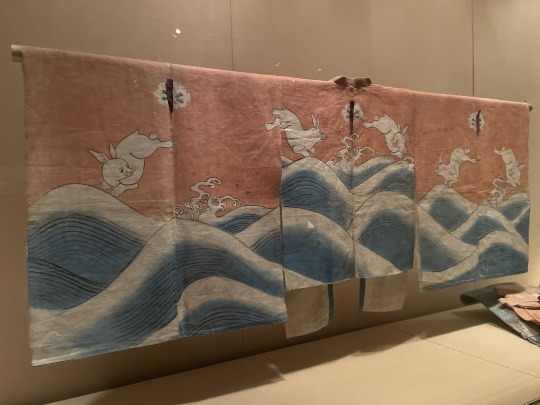



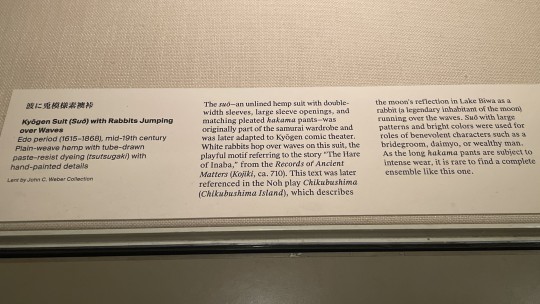
#LunarNewYear #YearOfTheRabbit at the Metropolitan Museum of Art, New York:
Kyōgen Suit (Suō) with Rabbits Jumping over Waves Japan, Edo period mid-19th century plain-weave hemp with tube-drawn paste-resist dyeing (tsutsugaki) with hand-painted details dimensions: Jacket (a): 31 1/8 × 71 in. (79.1 × 180.3 cm)
"The suō—an unlined hemp suit with double-width sleeves, large sleeve openings, and matching pleated hakama pants—was originally part of the samurai wardrobe and was later adapted to Kyōgen comic theater. White rabbits hop over waves on this suit, the playful motif referring to the story “The Hare of Inaba,” from the Records of Ancient Matters (Kojiki, ca. 710). This text was later referenced in the Noh play Chikubushima (Chikubushima Island), which describes the moon’s reflection in Lake Biwa as a rabbit (a legendary inhabitant of the moon) running over the waves. Suō with large patterns and bright colors were used for roles of benevolent characters such as a bridegroom, daimyo, or wealthy man. As the long hakama pants are subject to intense wear, it is rare to find a complete ensemble like this one."
Photographed on display at the Met's Kimono Style exhibition (catalog entry here).
#rabbit#rabbits#mammals#kimono#suō#Kyōgen#Kojiki#The Hare of Inaba#Chikubushima#textiles#historical costume#theatre#Japan#Japanese art#Asian art#19th century#Metropolitan Museum of Art New York#Kimono Style#exhibition#museum visit#animals in art
30 notes
·
View notes
Text
Kyohei Ishiguro's Bright: Samurai Soul Premieres Stunning New Trailer and Visual, Set for October Release
Kyohei Ishiguro's Bright: Samurai Soul Premieres Stunning New Trailer and Visual, Set for October Release #Bright #BrightSamuraiSoul #ネトフリアニメ #netflix #anime #イシグロキョウヘイ
Netflix made the announcement yesterday that the Spin-off Series titled Bright: Samurai Soul, based on the 2017 Original Sci-Fi Film Bright, which starred actor Will Smith would be premiering on October 12th. Taking place in Japan from the end of the Edo period to the Meiji period, depicting Izou, a ronin who lives as a bouncer, and Raiden, an orc assassin, who throws themselves into a fierce…

View On WordPress
#イシグロキョウヘイ#ネトフリアニメ#Anime#Bright#Bright: Samurai Soul#Kyohei Ishiguro#Kyōgen#Mansuku Nomura#Netflix#New Spin-Off-Series Announced#October 2021#Sci-Fi#Simu Liu#Yuki Nomura
4 notes
·
View notes
Photo

Back of a suō (jacket) with a design of lotuses, worn with trousers as a costume for a samurai lord in a kyōgen play
Japanese, Edo Period, early 19th century
resist-dyed and painted plain-weave bast fiber
Metropolitan Museum of Art
0 notes
Photo




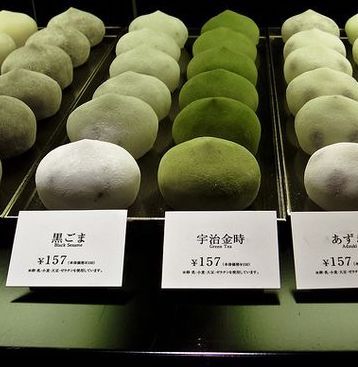
the japanese students
characters copied down with your favorite pen
the vibrant green of high-quality matcha
writing hiragana, katakana, and kanji until the symbols are familiar
strolling through a botanical garden
practicing suffixes, learning the social contexts that determine when different honorifics should be used
the satisfaction of seeing your grasp on the language improve
studying ancient poetry, reading pages of the man’yōshū
a scattering of cherry blossom petals in your hair
watching your favorite shows, recognizing the words and phrases you’ve learned and picking up new ones
recognizing the global influences of japanese culture
busy city streets and neon lights
picking up takeout from your local sushi restaurant
learning to cook authentic dishes
a stack of manga paperbacks with beaten-up corners and broken spines from each re-read
coming up with mnemonics to improve memorization
relishing the challenge of talking with a native speaker
the gently curved roofs of traditional architecture
organized notes, the title written at the top of the page in multiple alphabets
celebrating the theater traditions of noh and kyōgen
analyzing the intersections of japanese culture and contemporary western influences
studying various periods of history, from the Heian to the Meiji
#japanese#japanese student#japanese study#dark academia#dark academia aesthetic#light academia#light academia aesthetic#academia#academia aesthetic#student#student aesthetic#studying#studying aesthetic#studyblr#studyspo
817 notes
·
View notes
Photo

Nō or Kyōgen theater costume (Noshime-type)
1800-1849, Japan
Kasuri (ikat) weave silk
Purchase: William Rockhill Nelson Trus
Nelson-Atkins Museum of Art
233 notes
·
View notes